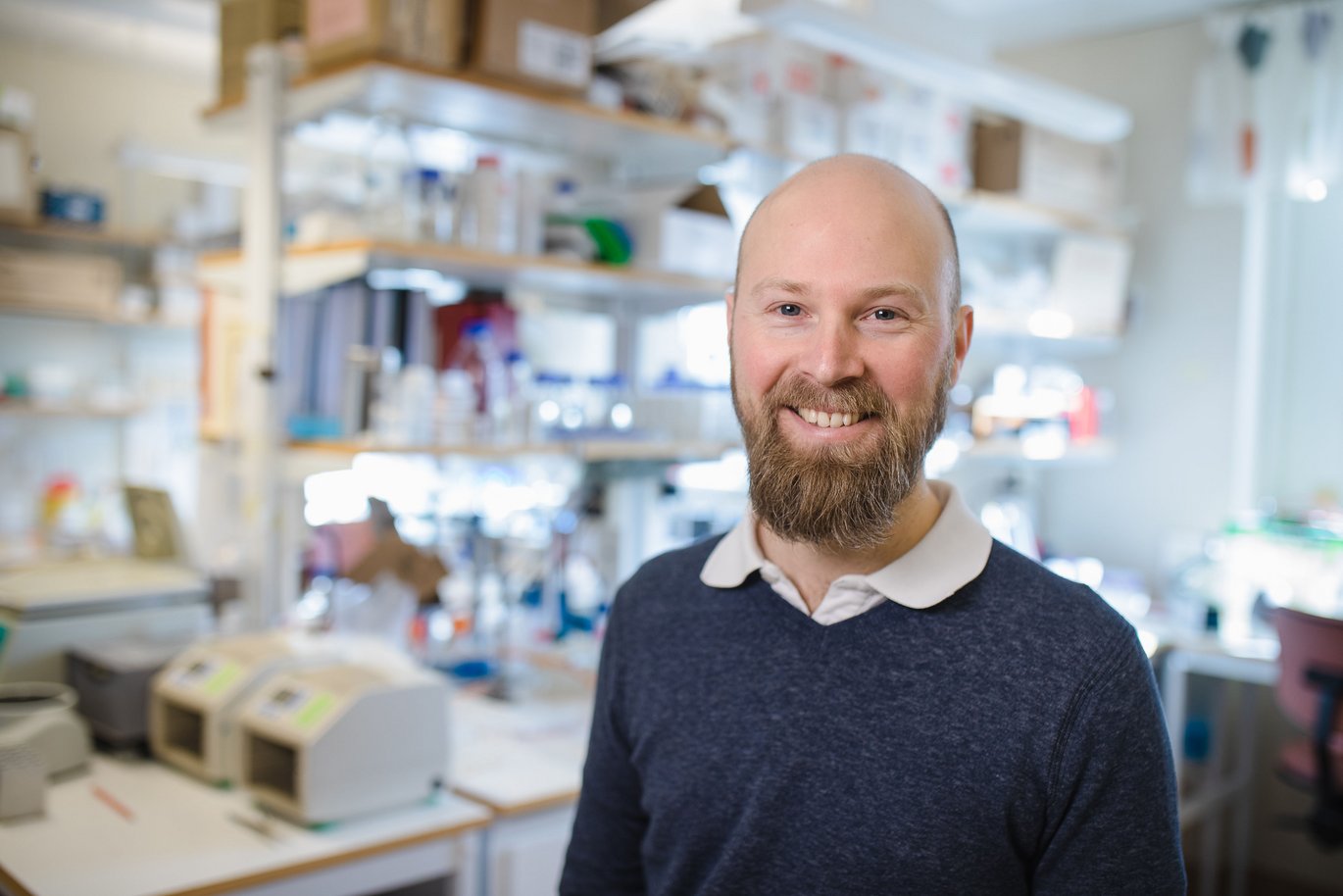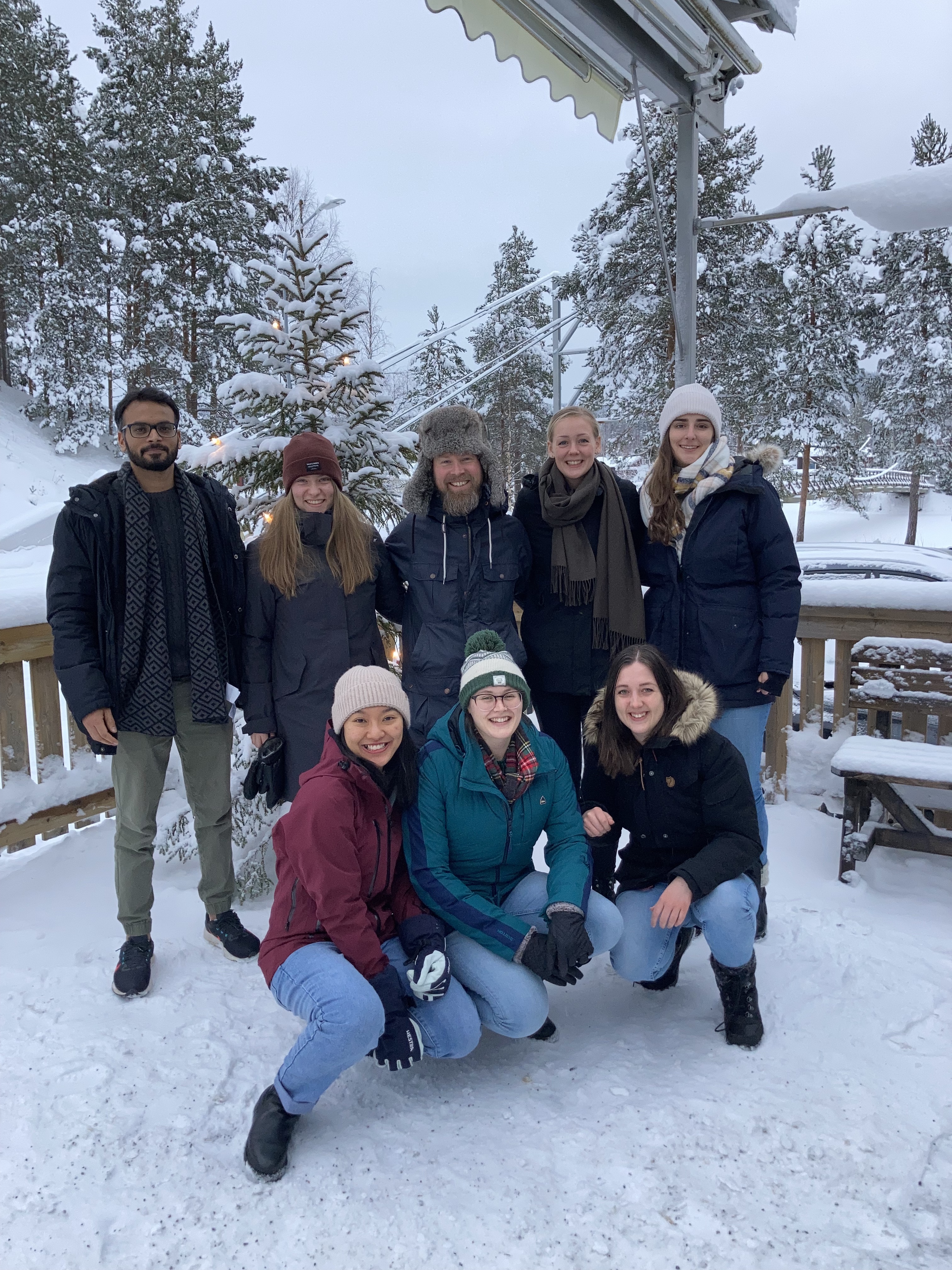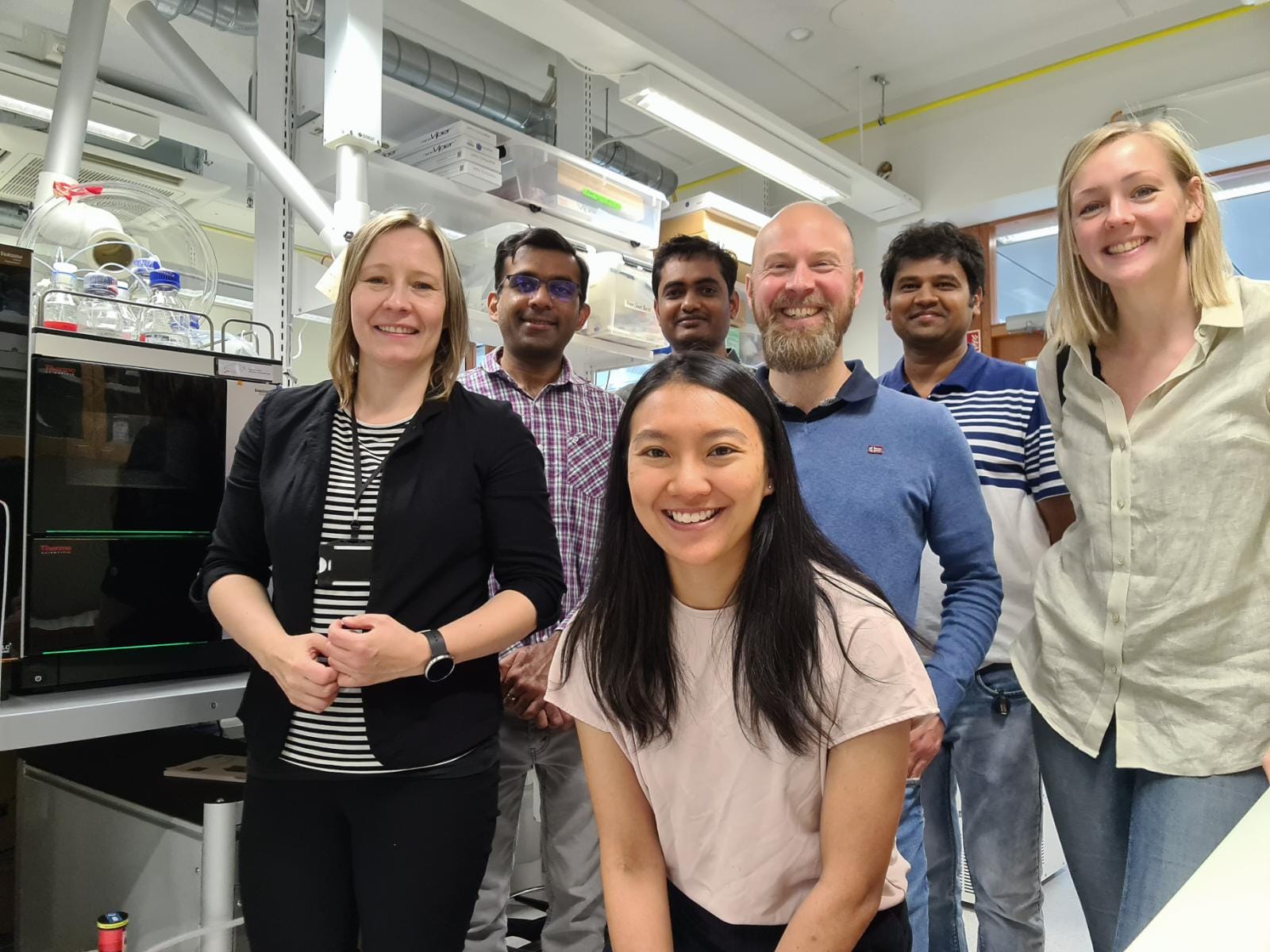Meet Björn Schröder: Uncovering how modern dietary habits affect the first line of defense in the gut
Meet MIMS Group Leader, Björn Schröder, and learn how and why he and his team are studying mucus function and host-microbe interactions in the gut.



The modern, Western-style diet offers a lot in the way of convenience, but at what cost?
Dr. Björn Schröder at The Laboratory for Molecular Infection Medicine Sweden (MIMS) and his research group are answering that question by examining how microbes in our gut affect the layer of mucus that sits between the gut lumen and the cells lining the gut.
When healthy, this layer of mucus - the intestinal mucosal barrier - is a semipermeable layer that allows absorption of nutrients. At the same time, it is a first line of defense, limiting transport of potentially harmful substances from the lumen into the epithelium. Microbes in the gut play an essential role in these functions as they interact with this intestinal barrier.
The Western-style diet causes a breakdown in the communication between gut microbes and the intestinal barrier, leaving the cell layer below vulnerable. Dr. Schröder wants to find out how to fix this relationship when it goes bad:
What we eat affects which gut bacteria are living in our body, what metabolites they produce, and how they then interact with us. Prof. Jeffrey Gordon (Washington University, St. Louis, USA), who is warmly known as ‘The Father of the Microbiome,’ once said that we should be good microbial farmers. I think this is a very nice expression. What should we feed our microbes so that they stay healthy, and so that we stay healthy in return?
The intestinal mucus layer is composed of heavily glycosylated proteins and water forming a gel-like sieve structure over the intestinal epithelium. Working with Profs. Fredrik Bäckhed and Gunnar Hansson at Gothenburg University in Sweden, Dr. Schröder has already demonstrated that a diet low in fiber and rich in carbohydrates and fat causes the intestinal barrier to become less dense and more penetrable. It can no longer keep bacteria in the gut at a distance, as it normally would, increasing the risk for infection and inflammation. It’s this protective nature of the intestinal mucosal barrier that is at the heart of Dr. Schröder’s research. He explains:
We are interested in how the mucosal layer functions so that we can help to prevent mucus dysfunction and the barrier defects that can occur as a result of diet. We try to understand what microbes are actually crucial to stimulate or educate the immune system in the gut. And maybe we can even figure out how to enrich the good microbes that we deplete when eating poorly.
Living tissue is the key
One of the highlights of Dr. Schröder’s research is to study the intestinal barrier in live tissue, a method previously developed and established by collaborators in Gothenburg. Working with live tissue, Dr. Schröder’s team can more accurately study mucus growth. He elaborates:
When water is removed during a typical tissue fixation process, the whole mucus shrinks to about 5-10 micrometers. That's a very small portion of the whole layer! Under these conditions, the growth or penetrability cannot be studied. Instead, we mount tissue from a healthy mouse with the mucus layer on top of a heated chamber. We measure thickness over time and calculate a so-called mucus growth rate, which in mice is about 2 µm/min.
And, the effect of diet on this growth rate is obvious. “With a Western style diet the growth rate is strongly reduced. It can be only 0.5 µm/min. The mucus which normally pushes microbes away from the epithelium can’t do that anymore.”
With the same Western-style diet intervention, the mucus layer also becomes penetrable, and bacteria reach the epithelial cell layer more easily. Dr. Schröder explains how they examine this:
To study penetrability, we use a confocal microscope and small, fluorescent beads. We stain the epithelium and mucus. We can then image from the side. In a healthy mouse we see the beads pretty much lining up on the surface of the mucus. And if it's not healthy, meaning penetrable, then these beads sink into the mucus, down towards the epithelium. We can identify and quantify where each bead is and what position it has. We can then calculate the so-called mucus penetrability.
These approaches to examine growth rate and penetrability in live tissue are laborious and currently done manually, but Dr. Schröder and his group are keen to automate at least parts of the processes in the future.
Dr. Schröder’s studies in mice have important implications in humans. Take inflammatory bowel disease, for example. He explains, “the team around Dr. Gunnar Hansson in Gothenburg has done two studies on people with ulcerative colitis, a type of inflammatory bowel disease, and they found a defect in the intestinal barrier. The mucus is penetrable from quite early in the disease.” In addition, people with metabolic diseases also appear to have a more penetrable mucus layer.
With their methods now optimized and studies underway in mice, Dr. Schröder and his team are ready to explore the interactions between gut microbiota and the intestinal barrier in humans. But such work is not without challenges, as he explains: “It's much more difficult to obtain live tissue biopsies from people than from mice. Healthy people don’t typically have a colonoscopy, so samples are very limited.”
A collaborative community of infection biology and beyond
Dr. Schröder built his independent research program and team at MIMS at Umeå University, a research environment known for its expertise in infection biology.
The generous starting package has given him a jump start in building his program. And, the diverse scientific focus areas represented create a community of interdisciplinary research. Dr. Schröder provides an example, “for our automation project, we often discuss with Dr. Johan Henriksson, who is much better on the technical and computational sides than we are.”
He also remarks that the atmosphere among group leaders is a supportive one and that it's very easy to start new collaborations locally. For example, recently initiated joint projects enable human studies. Dr. Schröder explains:
We are collaborating with nutritionists here in Umeå and a group in Germany who have done diet intervention studies. We are able to analyze stool samples from these studies. And we are now also trying to get even more to the clinical side by making connections to the hospital to get live tissue for our growth rate and penetrability studies.
Thanks to support from NordForsk for the Nordic EMBL Partnership Research Infrastructure Hub, Dr. Schröder and two group members initiated a collaboration with the experts in metabolomics, Dr. Anni Nieminen and her team, at the Institute for Molecular Medicine Finland (FIMM). FIMM is the Finnish node of the Nordic EMBL Partnership. He explains the basis of their work together:
We also want to understand how microbes communicate with the host and with the intestinal wall. This communication likely happens through metabolites, so it's very important for us to know what is actually produced by the microbes in a host organism. Metabolomics can help us quantify metabolites in the diet intervention study samples.
With a recent team visit to FIMM to learn the data analysis methods, Dr. Schröder and his team are well on their way to determining if there is a correlation between specific metabolites and a phenotype. And indeed, the collaboration with FIMM might have already picked up some interesting candidates.
Dr. Schröder is also driving institution-level collaborations through an EU Twinning project with the University of Tartu in Estonia and Basel Biozentrum, University of Basel in Switzerland. The project, entitled ‘Molecular Infection Biology Estonia - Research capacity building’ is coordinated by the University of Tartu and aims to strengthen research on latent and chronic infections at the University of Tartu’s Institute of Technology by creating long lasting links with well-established research institutions.
The project was initiated on the Swedish side by former MIMS group leader Dr. Vasili Hauryliuk who is now at the Department of Experimental Medical Science at Lund University. Dr. Schröder reflects on his experience in this new coordination role locally:
There's currently a lot of staff exchanges going on between MIMS and Tartu, and there will hopefully be some long-term collaborations coming out of this program. For me, it's a very nice experience to get involved in a coordinator role for an EU project. It’s something I can learn a lot from.
Motivation from science, mentors, and teamwork
As a young student and budding researcher, Dr. Schröder was motivated by science and a desire to know more:
I remember in school, in biology classes, I always wanted to know more. At that time I was really interested in how life works on a molecular level, the combination between chemistry and biology. I had a very research-oriented Masters and ended up going to the lab of Charles Bevins at UC Davis (USA) for three months. He's one of the pioneers on defensins, a specific class of antimicrobial peptides produced in the intestinal mucosa. And this is how I became interested in the mucosal defense system in the gut.
Dr. Schröder followed this interest to his PhD studies and postdoctoral research. His current research program at MIMS developed out of these experiences, including his biggest scientific breakthrough. He explains:
During my PhD thesis in the lab of Dr. Jan Wehkamp in Stuttgart I was really interested in how defensins kill gut bacteria. It was a dilemma. These peptides have disulfide bridges, three of them. In the field, it was thought that these disulfide bridges are crucial for activity. But, the environment in the gut is very different from the environment they were being studied in. In the gut, there’s a more anaerobic, reducing environment and different bacteria. So I was interested in how this interaction happens under these conditions.
However, he and others suspected that the defensins would lose activity in the reducing conditions. But, sometimes you just have to go against the theory and test it:
Most of the defensins became less active when I made a reducing environment, but there was one peptide, which actually got really active under these conditions. That was something which was completely unexpected, also because it was a defensin which was considered to not have any important function.
His persistence, and curiosity, paid off and with followup studies, the work was published in Nature in 2011, propelling his interest in gut bacteria and eventually the mucosal barrier, and leading him to postdoctoral fellowships with Prof. Fredrik Bäckhed and collaboration with Gunnar Hansson, both in Gothenburg.
Over the years Dr. Schröder’s mentors have left a lasting impression on him:
When looking back I think I always had really great mentors, supportive and able to bounce ideas around. It was stimulating to see their creativity and curiosity. I think that good mentors have a special passion, and they make it contagious.
At MIMS, Dr. Schröder has built a diverse research group - diverse, not only in nationality and career level, but also in scientific interests and expertise. He explains why:
I think diversity stimulates interaction, and makes it easier to tackle different types of scientific questions. Even though everyone in my group has their own project, many of the methods overlap. I want people to work together and experience a real team effort. For example, when there are a lot of animal measurements going on, it is too difficult for one person to do it alone. Science and progress are best in a group that is working as a team.
Nowadays, the lessons learned in mentorship influence how Dr. Schröder interacts with his own team, motivating him to incite a passion for science.
The best part of being a group leader is discussing experiments and results with people in the team - bouncing ideas forth and back. I try to foster independence as much as possible, encouraging them to come up with their own ideas and test them, as well. Of course I also keep an eye on what they are doing so I can also be supportive.
Science and society
From implications in the clinic for disease treatment or in the nutritional supplements industry for dietary intervention, the outcomes from Dr. Schröder’s discoveries are sure to have an impact on society, as he states:
Besides contributing to improved dietary recommendations for Western society, we hope to identify important bacteria that can be used as future probiotic supplements to improve barrier function in the gut. Moreover, we hope to find nutritional compounds that can provide long-term health benefits for our diseased Western guts.
Dr. Schröder is happy if his research program also raises awareness of how important gut bacteria are for our health, and how much influence we have on that microbial community.
And, he puts it simply, “it matters how we eat. If we treat our microbes well, they will treat us well. Remember that you're never eating alone!”
That’s food for thought the next time you walk into a grocery store. How will you feed your microbes and keep your intestinal barrier healthy?
Brief career summary
Dr. Björn Schröder was initially trained in biochemistry at the Max Planck Institute for Biochemistry (B.Sc., 2005) and at the Technical University of Munich (M.Sc., 2007). During his training, he completed two three-month internships, one with Prof. Charles Bevins at the University of California at Davis, USA, studying antimicrobial peptides, and one at Institut Pasteur in Paris, France, in the group of Prof. Philippe Sansonetti. He completed a Ph.D. degree in biology examining the interaction between antimicrobials and gut bacteria at the Dr. Margarete Fischer-Bosch-Institute of Clinical Pharmacology (IKP) in Stuttgart, Germany and the University of Tübingen, Germany, in the group of Dr. Jan Wehkamp in 2011. He began postdoctoral studies at IKP Stuttgart in the same year. In 2014, he continued postdoctoral research at the Sahlgrenska Academy at the University of Gothenburg, Sweden, and was promoted to Assistant Professor two years later. For his postdoctoral studies in Gothenburg, he was awarded prestigious Marie Skłodowska-Curie Actions and Human Frontier Science Program fellowships. Since 2019, Dr. Schröder has been a MIMS Group Leader at Umeå University, Sweden.
The article is published as part of the “Behind the Science'' profile series, taking an in-depth look at a scientist or group within the Nordic EMBL Partnership.